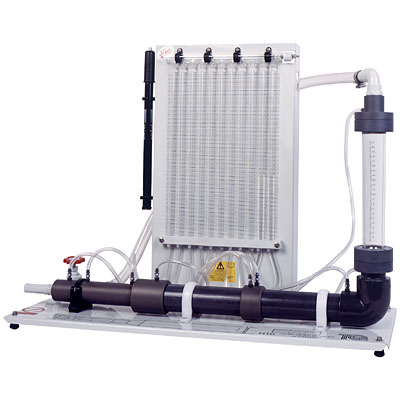
Use in Fluid Dynamics I lab.
Flow Measurement apparatus shows the typical methods of measuring the flow of an essentially incompressible fluid (water). It also shows applications of Bernoulli’s equation.
Students measure flow using a Venturi meter, an orifice plate meter and a rotameter. Bernoulli’s equation works for each meter. Students find and compare the head losses associated with each meter, as well as those arising in a rapid enlargement and a 90-degree elbow.
The apparatus is for use with a Gravimetric or Volumetric hydraulic bench. The equipment consists of a horizontal pipe including a gate valve, Venturi meter, orifice plate and pressure tappings. An elbow connects the pipe to a rotameter (gap-type flow meter) with further pressure tappings. All pressure tappings connect to manometers held on a vertical panel behind the pipe work. The manometers measure and clearly show pressure distribution against a calibrated scale.
To perform experiments, students connect the apparatus to the hydraulic bench supply, and set it to a low, steady flow through the apparatus. Water from the hydraulic bench then flows through the Venturi meter, through a rapidly diverging section, a settling length and the orifice plate. It then flows around the elbow, through the rotameter and finally returns to the hydraulic bench measuring tank.
Students measure the flow using the hydraulic bench, noting the manometer levels and rotameter reading. They then increase the flow in set increments, taking readings each time, until reaching maximum flow rate. They then use Bernoulli’s equation to find mass flow rate through each of the meters, comparing to flow rates measured using the hydraulic bench. Students can compare advantages, disadvantages and potential applications of each meter.
